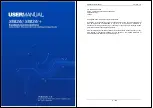
1. Set the Gateway's rotary dials to the Node address you'd like to conduct a Site Survey with.
For example, to analyze the signal strength between this Gateway and Node 02, rotate the left rotary dial to 0 and
the right rotary dial to 2.
The Site Survey automatically begins running. If there is no device at address 02, the LED is solid red. If there is a
device at address 02, the LED flashes amber.
2. Evaluate the signal strength. The amber LED flashes at specific rates to indicate the Site Survey results. Each signal
strength represents the majority of the data packets being received at that signal strength. For example, a strong
signal strength indicates the majority of the data packets were received at a strong signal, but a few may have been
received at a good or weak signal strength.
• Eight flashes per second: Very strong signal strength
• Four flashes per second: Strong signal strength
• Two flashes per second: Good signal strength
• One flash per second: Weak signal strength
• Solid amber LED: No radio communication detected
3. To exit the Site Survey, set the Gateway's rotary dials to 00. Otherwise, after 15 minutes the Gateway automatically
exits Site Survey mode.
The LED flashes green to indicate the Gateway is in standard operating mode.
3.6.3 Conduct a Site Survey Using Modbus Commands
Use Modbus commands sent from the host system to start a Site Survey.
To start a Site Survey using a Modbus write holding register command, send a control code of 32 (0x20) and the Node
number 1 through 47 (0x01 to 0x2F) to the Gateway Modbus holding register for I/O 15.
Modbus Register
[15:8]
[7:0]
I/O 15
Control Code
Data Field
I/O 15 Control Messages
Control Code
Data Field
Restrictions
Description
32
Node # 1–15
Gateway only
Enable Site Survey between Gateway and Node defined by the data field. All error
messages from the Gateway are ignored when running Site Survey.
Only one Node can participate in Site Survey at a time. To disable the Site Survey, use
control code 0x20 with Node 0. A Node must be enabled to run the Site Survey, then
disabled before selecting the next Node.
3.6.3 Example Command
Modbus Register
I/O 15
32
02
When Site Survey runs, the accumulated results are stored in the Gateway’s I/O 7 and I/O 8 holding registers. The LEDs on
the both the Gateway and the Node’s front panel display the signal strength for the wireless RF link. The quality of the
communications link is indicated by:
Green LED = excellent signal strength
Amber LED = good signal strength
Red LED = poor signal strength
The signal strength is the transmitted signal strength relative to the ambient RF signal present in a specific location, or noise
floor.
The Gateway also displays the Site Survey results on the LCD (for models with an LCD). For one transmit and receive
interval, the Gateway saves the lowest signal strength. The LCD and Modbus registers contain the results of the last 100
samples. The totals are a running tally of the last 100 samples and are continuously updated. Four categories are displayed:
G (green) = excellent signal strength
Y (yellow) = good signal strength
Sure Cross
®
Performance DX80 Wireless I/O Networks
18
www.bannerengineering.com - Tel: + 1 888 373 6767
















































